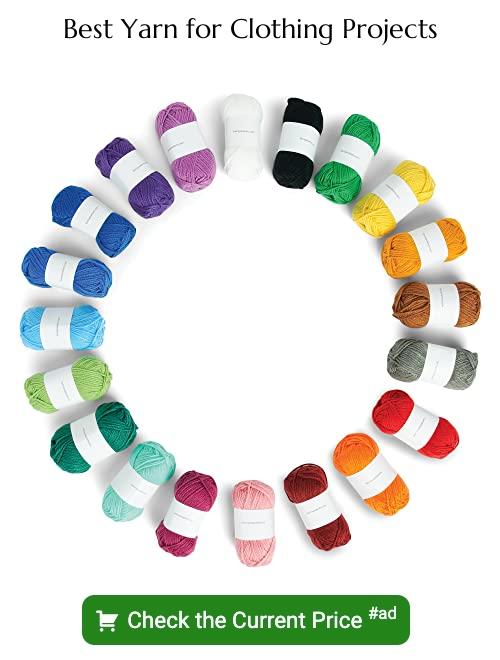Discover the fascinating world of yarn types for clothing as we explore their unique characteristics, applications, and how they contribute to creating stunning garments in this informative guide.
Are you a knitting or crocheting enthusiast looking for the perfect yarn to make your next clothing project? With so many different types of yarn available, it can be overwhelming to choose the right one. But fear not, my fellow crafters! In this article, we will explore the various types of yarn that are best suited for making clothing.
From soft and cozy wool to lightweight cotton blends, we’ll cover all the options so you can confidently select the perfect yarn for your next project. So grab your hooks and needles and let’s dive into the wonderful world of yarn!
Cotton Yarn
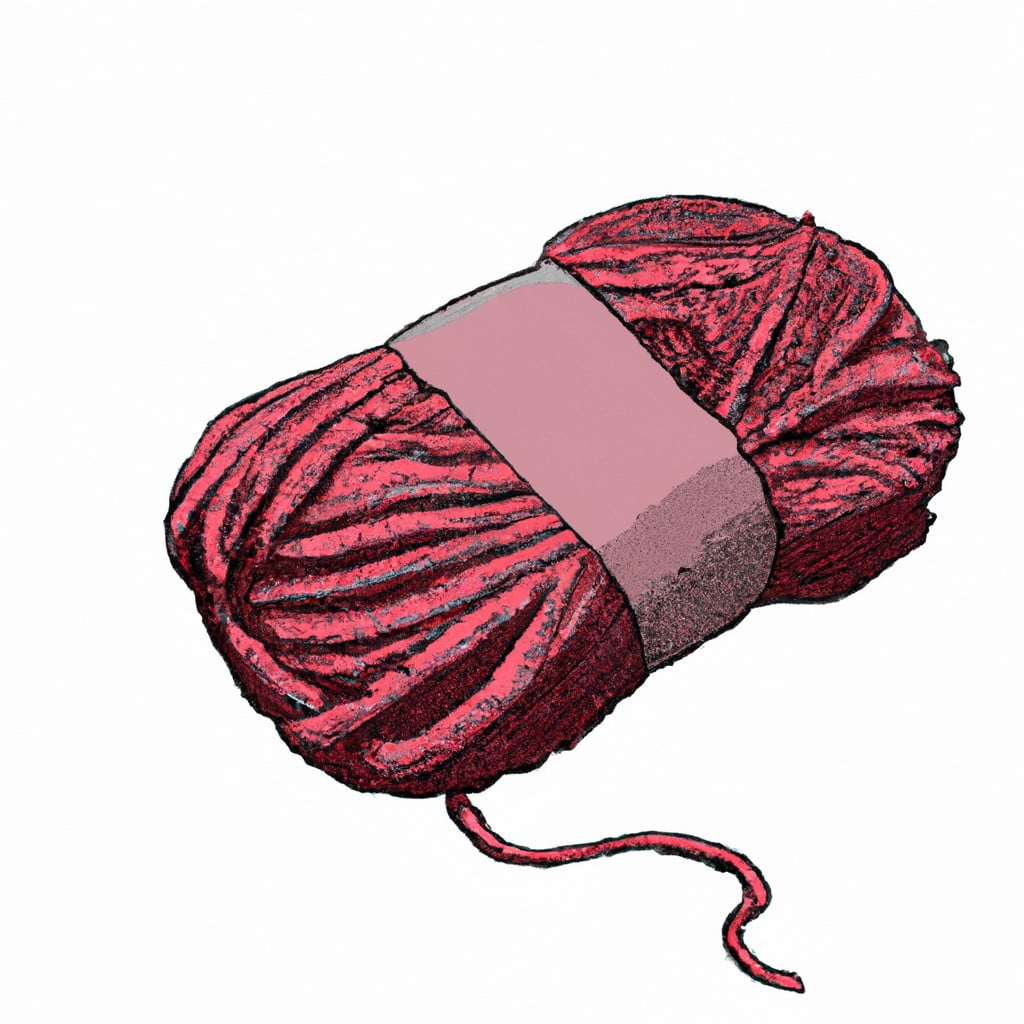
Cotton yarn is a popular choice for clothing projects due to its softness, breathability, and versatility. It’s perfect for creating lightweight garments that are comfortable to wear in warm weather.
Cotton yarn comes in different weights and textures, from smooth mercerized cotton to fluffy unmercerized cotton.
Mercerized cotton has been treated with sodium hydroxide or other chemicals that give it a lustrous sheen and make it stronger. This type of cotton is ideal for making summer tops, dresses, skirts or baby clothes because of its durability.
Unmercerized cotton has not undergone the same treatment as mercerized but still offers excellent stitch definition when used correctly. It’s great for making dishcloths or washcloths since it absorbs water well.
Wool Yarn
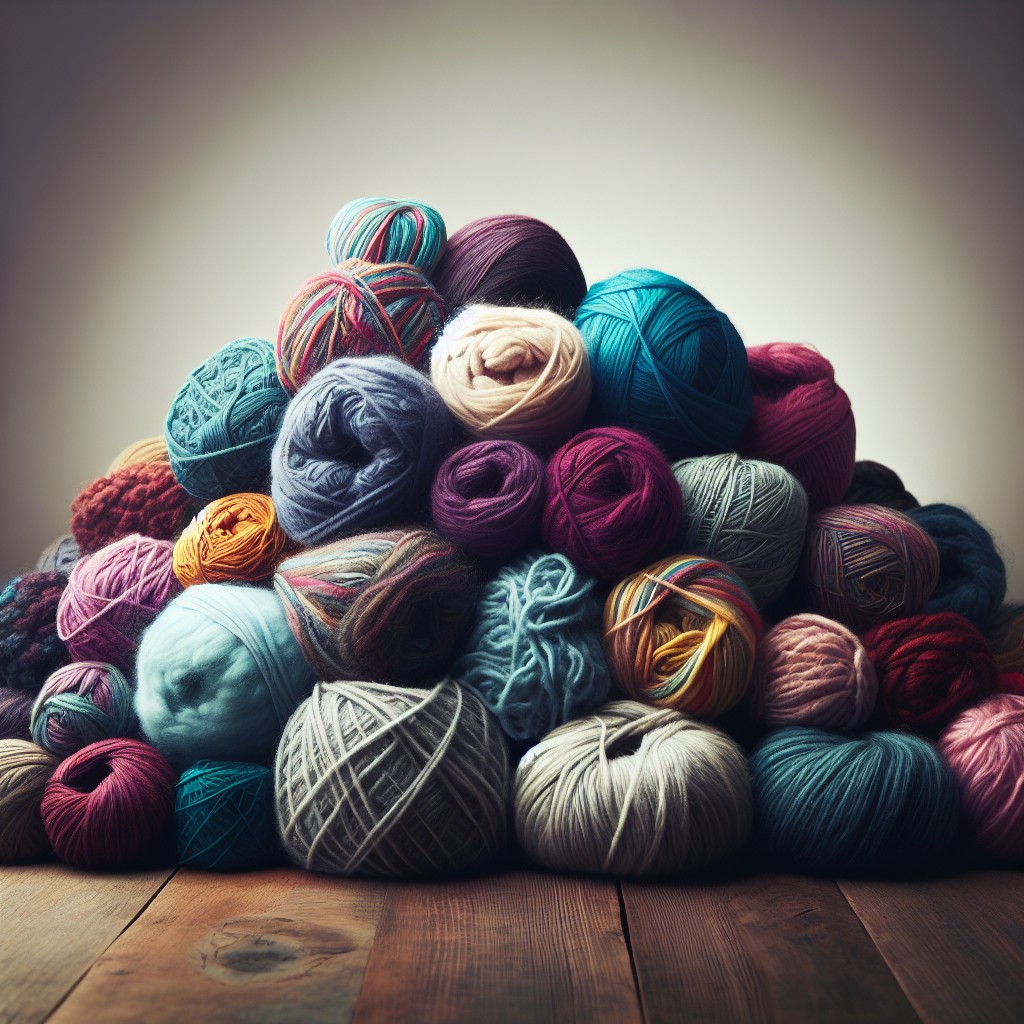
It comes in various types such as merino wool, which is known for its softness and elasticity; Shetland wool that has a rustic texture perfect for sweaters or outerwear; and Bluefaced Leicester wool that has long fibers ideal for lacework.
One of the benefits of using wool yarn is its natural insulation properties. Wool fibers trap air pockets between them creating an insulating layer that keeps you warm even when wet.
This makes it an excellent choice for winter garments like hats, scarves, mittens or sweaters.
Another advantage of using this type of yarn is its durability. Wool can withstand wear-and-tear better than other materials making it suitable not only as clothing but also home decor items like blankets or rugs.
When working with wool yarns keep in mind their care instructions since they may require special attention during washing to avoid felting (when the fibers stick together). Some wools are machine washable while others need handwashing with cold water and mild detergent followed by laying flat to dry.
Merino Wool Yarn
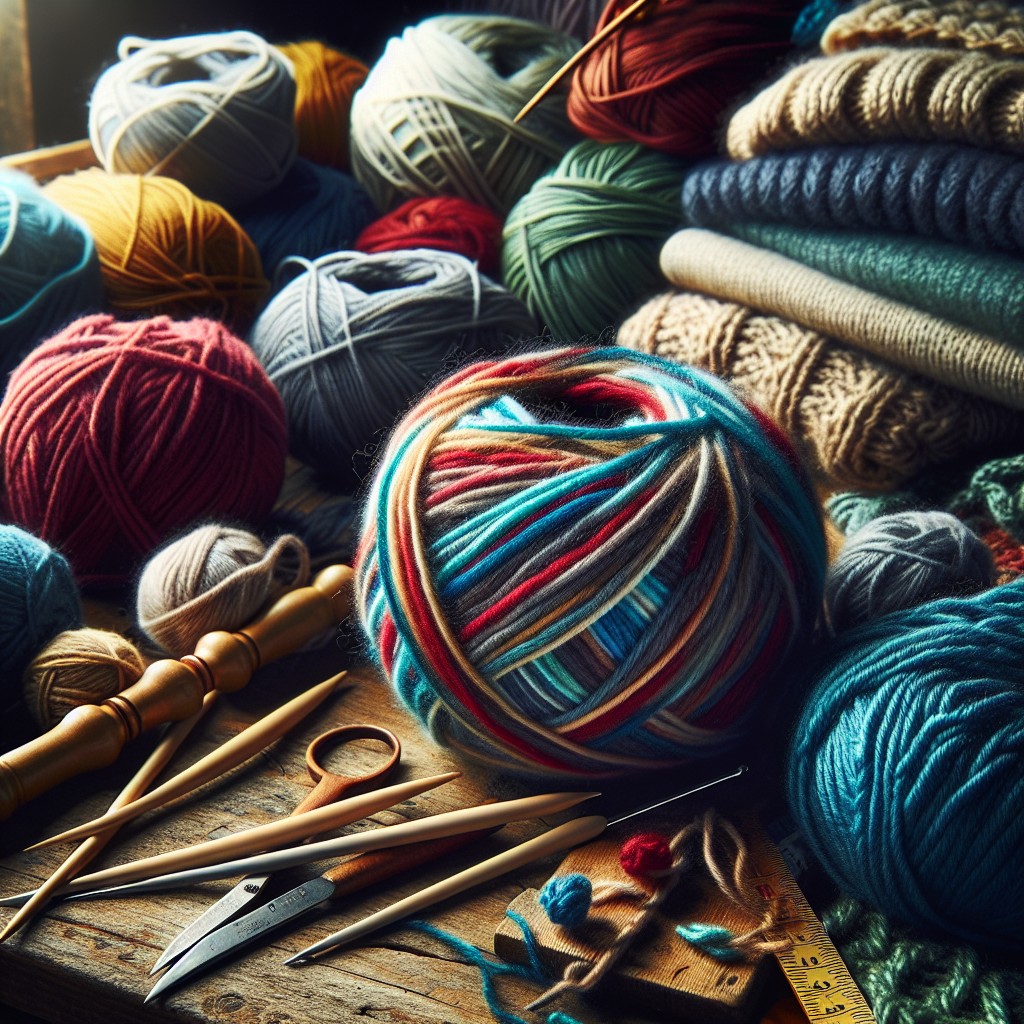
This type of wool comes from Merino sheep, which are known for their fine and soft fleece. Merino wool yarn is available in various weights and plys, making it suitable for different types of garments such as sweaters, scarves or hats.
One advantage of using merino wool yarn is that it has excellent moisture-wicking properties. This means that it can absorb moisture without feeling wet or clammy against the skin – perfect for activewear like socks or base layers.
Another benefit of merino wool yarn is its natural elasticity which allows the garment to stretch with movement while still retaining its shape over time. This type of fiber has antibacterial properties that help prevent odors from developing even after prolonged use.
When working with merino wool yarn be sure to follow care instructions carefully as some varieties may require hand washing rather than machine washing/drying cycles.
Alpaca Yarn
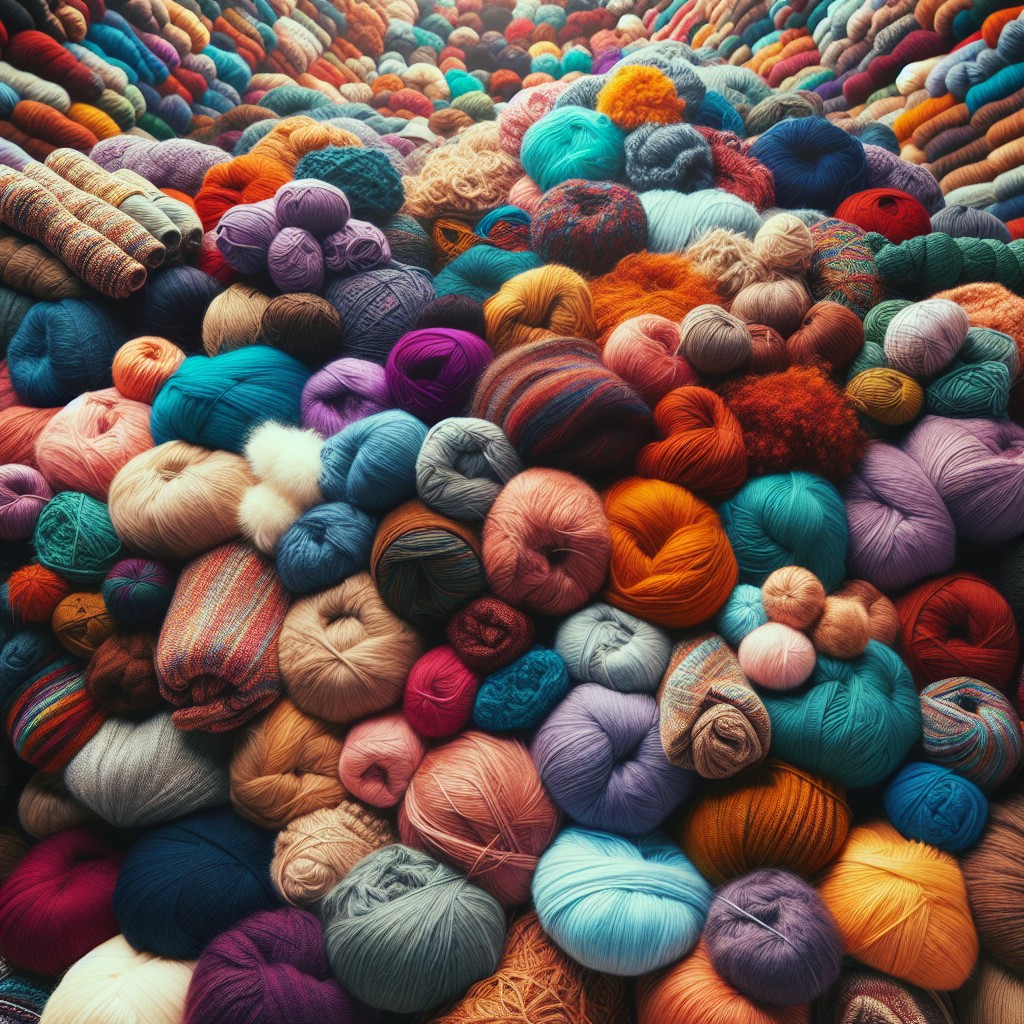
Alpacas are native to South America and produce a fiber that is similar to wool but much softer. Alpaca yarn comes in various natural shades, from white to black, with many beautiful hues in between.
One of the most significant advantages of using alpaca yarn for clothing projects is its warmth-to-weight ratio. It’s incredibly lightweight yet provides exceptional insulation against cold temperatures, making it perfect for winter garments like hats or scarves.
Another benefit of using alpaca yarn is its hypoallergenic properties. Unlike wool fibers that can cause itching or irritation on sensitive skin types, alpacas’ fibers are naturally smooth and free from lanolin oils found in sheep’s wool.
When working with this type of fiber blend (alpacas’ hair mixed with other materials), keep in mind that it tends to be more delicate than other types of animal-based fibers such as merino wool or cashmere; therefore requires gentle handling during washing and blocking processes.
Cashmere Yarn

Made from the undercoat of cashmere goats, this type of yarn has a fine texture that makes it ideal for creating cozy sweaters, scarves, hats and other winter garments.
One thing to keep in mind when working with cashmere yarn is that it can be quite expensive compared to other types of fibers. However, the investment may be worth it if you’re looking for high-quality materials that will last you many winters.
When shopping for cashmere yarns look out for labels indicating “100% Cashmere” or “Pure Cashmere”. These indicate high-quality products made entirely from pure cashmere fibers without any blends or fillers added.
It’s also important to note that while some people may have allergies or sensitivities to wool-based fibers like merino wool or alpaca wool; they are less likely to experience such reactions with pure 100% Cashmeres as they are hypoallergenic by nature.
Mohair Yarn
It’s known for its softness, sheen, and durability. Mohair yarn is often used in knitting or crocheting projects that require a fluffy texture or fuzzy appearance.
One of the benefits of using mohair yarn in clothing projects is its insulating properties. The fibers trap air between them, creating warmth without adding bulk to your garment.
This makes it an excellent choice for winter wearables like hats and scarves.
Another advantage of mohair yarn is its ability to hold dye well, resulting in vibrant colors that don’t fade easily over time. Its lustrous shine also adds depth and dimension to any project you create with it.
However, there are some things to keep in mind when working with mohair yarn as it can be challenging due to its fuzziness and slipperiness on needles or hooks compared with other types of wool fibers such as merino wool.
Angora Yarn
It’s known for its fluffy texture, warmth, and halo effect. This type of yarn is perfect for creating cozy sweaters, scarves, hats or any other winter clothing item you can think of.
One thing to keep in mind when working with angora yarn is that it sheds quite a bit during the knitting process. So be prepared to have some fuzz on your clothes while you work with it! However, once your project is complete and washed properly (using cold water), shedding should no longer be an issue.
Another important consideration when using angora yarn is that it requires gentle handling due to its delicate nature. Avoid pulling too hard on the fibers as they can easily break or become matted together.
Llama Yarn
Llamas are native to South America and have been bred for their woolly coats, which produce a luxurious fiber that’s similar to alpaca but with more loft. Llama yarn is lightweight yet incredibly warm, making it perfect for cozy sweaters or scarves.
One of the benefits of using llama yarn is its natural resistance to water and dirt. This means your finished garment will be easy to care for and maintain over time.
Because llamas are raised in high altitudes where temperatures can fluctuate drastically between day and night, their wool has evolved into an insulating material that keeps them comfortable in all conditions.
When working with llama yarns keep in mind they tend towards being hairy rather than fuzzy like other animal fibers such as mohair or cashmere; this makes them less likely to pill over time but may require some extra attention when blocking your finished project.
Hemp Yarn
It’s made from the fibers of the hemp plant and is known for its durability, strength, and resistance to mold and mildew. Hemp yarn can be blended with other fibers like cotton or silk to create unique textures in your projects.
One of the benefits of using hemp yarn in your clothing projects is that it’s eco-friendly. Hemp plants require less water than cotton plants do when growing which makes them more sustainable overall.
They don’t require pesticides or herbicides as they are naturally resistant to pests.
Another advantage of using hemp yarn in your knitting or crocheting project is its breathability properties which make it ideal for summer garments such as tank tops or lightweight shawls.
When working with hemp yarns keep in mind that they tend not stretch much so you may need larger needles than usual if you want a looser fabric texture.
Bamboo Yarn
This type of yarn is made from bamboo grass, which grows quickly and requires minimal water and pesticides. Bamboo yarn has a silky texture that drapes beautifully, making it ideal for creating lightweight garments such as summer tops or shawls.
One of the benefits of using bamboo yarn is its breathability. It wicks away moisture from the skin, keeping you cool in hot weather while also providing warmth in cooler temperatures.
Bamboo fibers have natural antibacterial properties that make them resistant to odors and mildew.
When working with bamboo yarns, it’s important to note that they can be slippery on needles or hooks due to their smooth texture. However, this can be easily remedied by using needles with sharper tips or adjusting your tension accordingly.
Silk Yarn
It has a natural sheen that gives garments an exquisite look and feel. Silk yarn is made from the fibers of silkworm cocoons, which are spun into fine threads.
One of the most significant advantages of silk yarn is its breathability, making it ideal for summer clothing items such as lightweight tops or dresses. Silk’s moisture-wicking properties make it comfortable to wear in warm weather.
Another benefit of using silk yarn in your knitting or crocheting project is its durability; garments made with this type of fiber can last for years if cared for properly.
When working with silk yarn, keep in mind that it can be slippery and challenging to work with at times due to its smooth texture. However, once you get used to handling it correctly (using smaller needles/hooks), you’ll find that creating beautiful pieces becomes more manageable than ever before!
Linen Yarn
Made from the fibers of the flax plant, linen yarn has been used for thousands of years in various forms, including clothing and household textiles. Linen yarn is known for its durability and strength, making it an excellent choice for garments that will see frequent use.
One thing to keep in mind when working with linen yarn is that it can be quite stiff at first but softens up beautifully after washing. It’s also important to note that linen tends to have less elasticity than other types of fibers like wool or cotton, so you may need to adjust your tension accordingly.
When selecting a linen yarn for your project, look out for labels indicating whether the fiber has been treated with chemicals or not. Organic linens are becoming more widely available as people become more conscious about sustainability and environmental impact.
Acrylic Yarn
It’s made from synthetic fibers that are easy to care for and come in a wide range of colors. Acrylic yarn is perfect for beginners or those on a budget who want to create beautiful garments without breaking the bank.
One thing to keep in mind when working with acrylic yarn is that it can be prone to pilling (small balls of fuzz) over time. To prevent this, choose high-quality acrylics with longer fibers and avoid using fabric softeners when washing your finished projects.
Another benefit of acrylic yarn is its ability to hold up well against wear and tear, making it an excellent option for items like blankets or scarves that will see frequent use. Plus, since it’s machine washable and dryable, cleaning your creations couldn’t be easier!
Polyester Yarn
It’s made from petroleum-based products and is known for its durability, strength, and resistance to wrinkles. Polyester yarn can be used on its own or blended with other fibers to create a wide range of fabrics.
One of the benefits of using polyester yarn for clothing is that it’s easy to care for. Unlike natural fibers like wool or cotton, polyester doesn’t shrink when washed and dries quickly without needing ironing.
Another advantage of using polyester yarn in clothing projects is that it comes in many different colors and textures. This makes it an excellent choice if you’re looking to add some variety or vibrancy into your wardrobe.
However, there are also some downsides associated with this type of synthetic fiber as well. For example, while durable against wear-and-tear over time compared with natural materials such as wool; however they do not breathe well which may cause discomfort during hot weather conditions due their lack ventilation properties.
Rayon Yarn
Made from regenerated cellulose fibers derived from wood pulp or bamboo, rayon yarn has a silky texture that makes it ideal for creating lightweight garments such as summer tops and dresses.
One of the benefits of using rayon yarn is its versatility. It can be blended with other fibers like cotton or polyester to create unique textures and colors.
Rayon also takes dye well which means you can achieve vibrant hues in your finished garment.
However, there are some downsides to consider when working with this type of yarn. Rayon tends to stretch out over time so it’s important to take gauge measurements before starting your project and adjust accordingly if necessary.
Rayon requires special care when washing as it may shrink or lose shape if not handled properly.
Nylon Yarn
It’s often used in clothing items that require stretch, such as socks or activewear. Nylon yarn can also be blended with other fibers to add strength and elasticity to the finished garment.
One of the benefits of nylon yarn is its resistance to abrasion, making it ideal for garments that will see a lot of wear and tear. Nylon has excellent moisture-wicking properties which make it perfect for athletic apparel.
When working with nylon yarn, keep in mind that it can be slippery on needles or hooks due to its smooth texture. This may take some getting used to if you’re accustomed to working with natural fibers like wool or cotton.
Yarn Fiber Blends
These types of yarns are made by combining two or more fibers to create a unique blend with enhanced properties such as softness, durability, and warmth.
Some popular fiber blends include wool and silk, cotton and linen, alpaca and merino wool. Each blend has its own unique characteristics that make it ideal for specific projects.
For example, if you want to knit or crochet a sweater that is both warm and lightweight at the same time – consider using alpaca-merino wool blend. If you prefer working with plant-based fibers but still want some added strength – try out cotton-linen mixtures.
When selecting your next project’s yarn type from blended options available in stores or online shops – pay attention to their composition percentages on labels (e.g., 70% Merino Wool/30% Silk).
Novelty and Specialty Yarn Types
These yarns come in a variety of styles such as boucle, ribbon, eyelash, ladder or tapestry. They can be made from various fibers including wool blends or synthetic materials like nylon.
Boucle is an excellent choice for creating textured garments with its looped appearance that adds depth and dimensionality. Ribbon yarn has a flat shape that creates beautiful draping effects when used in shawls or scarves.
Eyelash yarn mimics the look of fur with its long strands protruding from the base fiber while ladder/tapestry style features small sections of different colors woven together into one strand for added visual appeal.
When using novelty/specialty yarns it’s important to keep in mind their unique characteristics which may require special handling during knitting/crocheting process such as avoiding tight stitches so they don’t get lost within the loops/strands.
Yarn Weights and Types
Yarn weight refers to the thickness of the strand or ply and can range from lace weight (the thinnest) to super bulky (the thickest). Each weight category has its own recommended needle size, gauge specifications, and ideal applications.
Lace-weight yarns are perfect for delicate shawls or intricate lacework. Fingering-weight yarns are great for lightweight garments like socks or baby clothes.
Sport- and DK-weight yarns work well for sweaters, scarves, hats, mittens – you name it! Worsted- and aran-weight yarns make cozy blankets or thick winter accessories while bulky-weights create quick projects with a lot of texture.
It’s important to note that not all types of fibers come in every weight category; some fibers may only be available in certain weights due to their unique characteristics. For example: cotton tends towards lighter weights while wool is often found in heavier ones.
Yarn Ball Labels
The label contains valuable information that can help you choose the right type of yarn for your project. Most labels include details such as fiber content, weight category, yardage/meterage per skein or ball and recommended needle size.
The fiber content is particularly important because it determines how soft or durable a garment will be. For example, wool is known for its warmth and elasticity while cotton is lightweight and breathable.
Weight category refers to how thick or thin a strand of yarn is which affects both drape and stitch definition in your finished piece. Yarns are typically categorized into seven different weights ranging from lace (the thinnest) up through super bulky (the thickest).
Yardage/meterage per skein/ball tells you how much length there actually exists in one unit of purchase so that you can calculate if enough quantity has been purchased based on pattern requirements.
Recommended needle size gives an idea about what kind of needles should be used with this particular type/weight/category/fiber blend etc., making sure that stitches come out even without being too tight nor too loose.
Ideal Needle Sizes
The thickness of your yarn and the desired drape of your finished garment will determine which needle size is best suited for your project. Generally, thicker yarns require larger needles while thinner ones need smaller needles.
It’s important to note that different types of knitting or crochet stitches may also require different needle sizes. For example, if you’re working on a lace pattern with intricate details, you’ll want to use smaller needles than what’s recommended on the label.
Yarn Gauge Specifications
Yarn gauge refers to the thickness of a particular type of yarn and is measured by wraps per inch (WPI). The higher the WPI number, the thinner and lighter weight the yarn will be.
Conversely, lower WPI numbers indicate thicker and heavier weight yarns.
It’s important to pay attention to recommended gauge specifications on your pattern or label as using an incorrect size can result in a garment that doesn’t fit properly or has an uneven texture. To determine if you have selected a suitable match for your pattern requirements, use a swatch test before starting any project.
Remember that different types of fibers may behave differently when knitted or crocheted at specific gauges; therefore it’s essential always to check with each new fiber type used.
Care Instructions
Different types of yarn require different care instructions, so be sure to read the label carefully before washing or drying. Some fibers can shrink or felt if exposed to high temperatures or agitation in a washing machine.
For natural fibers like wool and alpaca, hand-washing in cool water with a gentle detergent is usually recommended. Avoid wringing out excess water and instead gently squeeze out as much moisture as possible before laying flat on a towel to dry.
Cotton and linen blends are often machine washable but should be washed on cold with similar colors and tumble dried on low heat. Synthetic fibers like acrylics can also typically be machine washed but may need special attention when drying to avoid stretching or pilling.
Yarn for Sensitive Skin
Scratchy or rough fibers can cause irritation and discomfort, making it difficult to wear your handmade garments with confidence. Fortunately, there are many types of yarn that are gentle on sensitive skin.
One option is cotton yarn which is soft and breathable. It’s also hypoallergenic and easy to care for, making it a great choice for those with allergies or sensitivities.
Another excellent choice is bamboo yarn which has natural antibacterial properties that make it resistant to odors and mildew growth. It’s also incredibly soft against the skin while being lightweight enough to keep you cool in warmer weather.
For those who prefer animal fibers but still need something gentle on their skin, alpaca wool may be an ideal option as its fiber structure makes it less irritating than other wools like sheep wool or mohair.
When selecting a type of yarn for sensitive skin always check the label carefully before purchasing any new skeins; look out specifically if they contain synthetic materials such as acrylics because these can often irritate delicate areas like necklines where friction occurs most frequently during wear time.
Yarn for Beginners
But don’t worry! There are plenty of beginner-friendly options available that will make your first project a success. When choosing yarn for beginners, it’s important to consider factors such as texture, weight, and ease-of-use.
One great option for beginners is acrylic yarn. This synthetic fiber is affordable and easy to work with since it doesn’t split or tangle easily like some natural fibers do.
Acrylic also comes in a wide range of colors and textures so you can find something that suits your style.
Another good choice for beginners is wool-blend or cotton-blend yarns which offer both durability and softness while being easy on the hands when working with them.
When starting out with knitting or crocheting projects using thicker weight (bulky) 4-5 category size 6-7mm needles/hooks would be ideal as they allow you to see progress quickly without getting bogged down by intricate details. Remember: The most important thing when selecting any type of beginner-friendly-yarn is finding one that feels comfortable in your hands while providing enough structure so stitches stay put but not too stiff where they become difficult manipulate into place during stitching sessions.
Yarn Weight Categories
Yarn weight refers to the thickness of the strand and can range from super fine (lace) to super bulky. Each category has its own recommended needle size and gauge specifications, which determine how many stitches per inch you should aim for.
The most common yarn weights used in clothing projects are DK (double knitting), worsted/aran, and bulky/chunky. DK is a lightweight option that works well for summer garments or delicate shawls while worsted/aran provides more warmth and structure making it ideal for sweaters or cardigans.
Bulky/chunky is perfect if you’re looking to create cozy winter wear like hats or scarves.
It’s important to note that different brands may have slightly different definitions of each weight category so always check your pattern requirements before purchasing any yarns.
Yarn Ply and Structure
Ply refers to how many strands of fiber are twisted together to make a single strand of yarn. The more plies a yarn has, the stronger and more durable it will be.
Single-ply yarns have only one strand and tend to be softer but less sturdy than multi-ply options. Two- or three-ply options are common in most types of fibers used for clothing projects.
The structure also plays an essential role in determining how well your garment will hold up over time. Some popular structures include smooth, tightly spun singles; loosely spun singles with lots of texture; cabled or plied constructions that add strength; boucle (looped) textures that create interest without adding bulkiness.
Types of Yarn: Printable Summary
With so much information to keep track of, it can be helpful to have a printable summary on hand that you can refer back to as needed. This summary could include the various yarn types and their characteristics, recommended needle sizes and gauge specifications for each type, care instructions, and any other relevant details.
Having a printable reference guide like this can save time when shopping for yarn or starting a new project. You’ll be able to quickly identify which type of yarn is best suited for your needs without having to sift through pages of notes or online articles.
Tip #3: Be Careful With Acrylics
However, it’s important to be careful when using acrylics for clothing projects. While they are durable and machine-washable, acrylic fibers do not breathe well and can cause discomfort or even skin irritation in some people.
The synthetic nature of acrylics means that they don’t have the same moisture-wicking properties as natural fibers like cotton or wool.
If you’re set on using acrylic yarn for your next clothing project, consider blending it with other fibers such as cotton or wool to improve breathability and comfort. Alternatively, reserve your use of acrylics for non-clothing items like blankets or home decor where their durability is an asset rather than a liability.
Tip #5: No Fuzz
Fuzz refers to the small fibers that come off of a yarn as you work with it. While some fuzz is normal and can add texture and depth to your finished piece, too much can be distracting or even ruinous.
Tip #5: No Fuzz.
If you’re looking for a smooth finish on your garment, avoid using fuzzy yarns like mohair or angora. These types of yarn are known for their softness but also tend to shed quite a bit during use which could make them unsuitable if you want clean lines in your design.
Instead, opt for smoother options such as cotton or silk blends that will give you crisp stitch definition without any unwanted fluffiness. If working with wool-based fibers like merino wool or alpaca fiber (which have natural oils), ensure they are well spun before purchasing so they don’t pill easily while being worked on.
Tip #6: No Non-Superwash Animal Fibers
That’s where Tip #6 comes in: avoid non-superwash animal fibers. While these types of yarn can be incredibly soft and luxurious, they require special care when washing and may not hold up well over time.
Non-superwash animal fibers such as wool or alpaca have not been treated with a chemical process that prevents felting or shrinking when washed. This means that if you accidentally toss your handmade sweater made from non-superwash wool into the washing machine, you could end up with a shrunken mess.
On the other hand, superwash wool has been treated so that it can withstand being machine-washed without felting or shrinking. This makes caring for garments made from this type of yarn much easier and more convenient.
Favorite Summer Yarns
Here are some of our favorite summer yarns that will keep you cool while creating stunning garments:.
1. Cotton Yarn: This versatile fiber is a popular choice for summer clothing due to its breathability and softness.
2. Bamboo Yarn: Made from bamboo grass, this eco-friendly option has a silky texture and drapes beautifully.
3. Linen Yarn: Known for its durability, linen yarn becomes softer with each wash making it an excellent choice for summertime wear.
4. Silk Blends: A luxurious blend of silk and cotton or silk and linen creates a beautiful drapey fabric that’s perfect for warm weather garments.
5. Hemp Yarn: This sustainable fiber has natural anti-bacterial properties which make it ideal for hot weather clothing items like tank tops or shorts.
Whether you’re looking to create light cardigans, breezy tops or flowy dresses – these fibers will help bring your vision to life in the most comfortable way possible!.
Yarn Type Comparison Chart
That’s where a yarn type comparison chart comes in handy! This chart allows you to easily see the differences between different types of yarn, such as fiber content, weight category, and recommended needle size. You can use this tool when selecting your next project’s materials or when substituting one type of yarn for another.
When creating your own comparison chart, consider including additional information that is important to you personally. For example, if you’re looking for vegan-friendly options or hypoallergenic fibers due to sensitive skin issues.
FAQ
What yarn should you use for clothes?
The ideal yarn for clothes is often one fiber yarns like 100% cotton or 100% wool, although some mixed yarns may also be suitable for washing.
What kind of yarn is used in the fabric?
The kind of yarn used in the fabric can be made from natural fibers like wool, silk, cotton, and linen or synthetic fibers such as nylon, acrylic, and polyester.
What kind of yarn is best for crocheting clothes?
Answer: Fingering weight yarn, also known as super fine, sock, or baby yarn, is best for crocheting clothes due to its light weight and ability to provide great drape and warmth.
What are the 3 major yarn categories?
The 3 major yarn categories are Animal Fibers, Plant Fibers, and Synthetic Fibers.
Which type of yarn is most suitable for knitting sweaters?
Yarn type most suitable for knitting sweaters: Worsted-weight yarn.
How does the choice of yarn affect the breathability and comfort of clothing?
The choice of yarn affects the breathability and comfort of clothing because different yarn materials determine the garment’s moisture-wicking properties, softness, and overall feel on the skin.
What are the sustainability factors to consider when choosing yarn for clothing?
When choosing yarn for clothing, consider sustainability factors such as material source, biodegradability, eco-friendliness, chemical processing, and fair labor practices.
